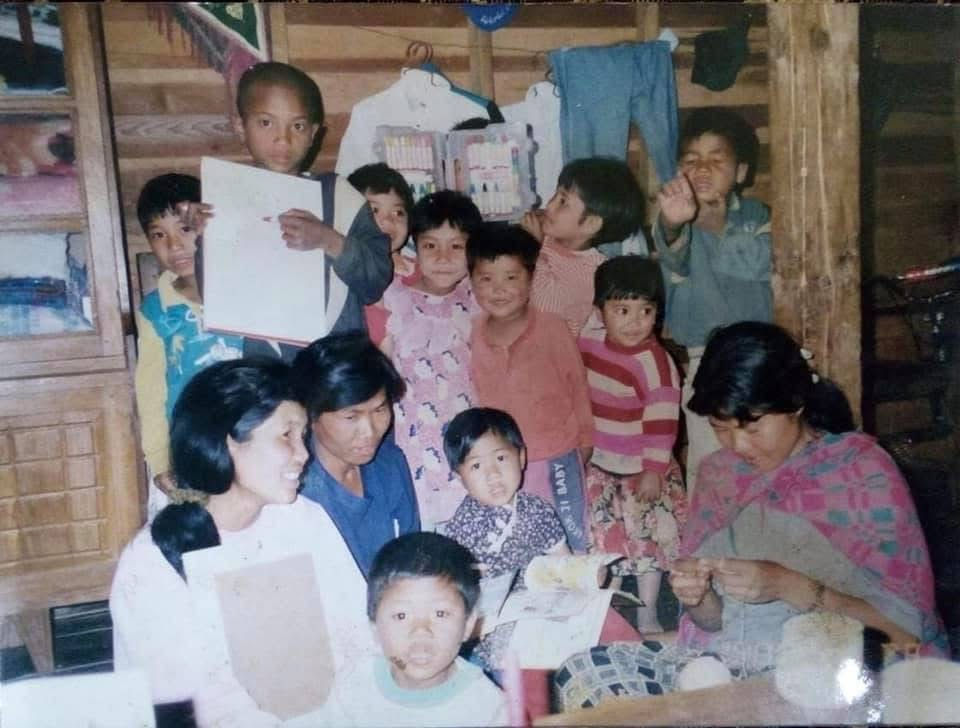Threads of Accountability
- Sarah Moreland Byrne

- Apr 15, 2022
- 5 min read
Updated: May 22, 2023
This past February, the high-powered glitz of New York Fashion Week culminated in a “no waste dinner” where leaders of the eco-conscious crowd, like blogger-activist Lauren Singer and Greenpeace co-founder Paul Watson, mingled with influential names in fashion– including Gabriella Karefa-Johnson, the first Black woman to style a Vogue magazine cover; IMG Models President, Ivan Bart; Ella Emhoff, the fashion-forward stepdaughter of Vice President Kamala Harris; and Indigenous model Quannah Chasinghorse, who was photographed wearing a black T-shirt that read “The Earth Is Not Ours.”
It’s not the first time the two seemingly antagonistic worlds have collided. Stella McCartney’s been leading the way for more than two decades, launching sneakers made out of recycled ocean debris and excluding leather and fur from her designs. Top fashion magazines started hiring “sustainability editors’’ once they realized the topic was here to stay. And thrift stores have existed for more than 100 years, though the stigma of shopping their racks has roller-coastered. But as Vogue Business’ Sustainability Editor Rachel Cernansky points out, when it comes to eco-conscious style, there’s been a lot more talk – and flashy events, I’d add – than action.
If sustainable fashion isn’t a new concept, then why is waste still a problem? And why does it seem like we’re just now trying to come up with better solutions?
As a member of the oft-derided Millennial generation, I’m loath to overgeneralize large groups of people, but facts are facts: If anyone’s going to save the planet, it’s Gen Z. You see it in headlines: “Gen Z Emerging as Sustainability Generation” (Forbes), “Gen Z Flocks to Climate Change Career Jobs” (The Guardian), “Gen Z Willing to Pay More for Eco-Friendly Products” (Ad Age). Americans born after 1996 are the generation most likely to say their biggest concern is the environment, according to the Pew Research Center. And they have the highest percentage of people who have taken action – like contacting elected officials, volunteering, attending rallies or donating money – to combat environmental issues. Greta Thunberg may be the most famous face of the movement, but she’s just one of many.

Natalia Trevino Amaro is also a part of that movement. The 22-year-old designer already has a resume that would make Project Runway devotees salivate: After graduating from Carmel High School in Indiana, she was accepted into three of the top fashion schools in the country: the Pratt Institute, Savannah College of Art and Design and – her top choice – the Fashion Institute of Technology (FIT). She spent her first year in Florence, Italy, with FIT’s international fashion design program, taking field trips to textile manufacturers and a screenprinting lab for luxury brands – think Hermès and Louis Vuitton’s signature scarves – and attending Paris and Milan fashion weeks. She followed this up with an internship at NYC-based Cucculelli Shaheen, known for romantic hand-embroidered and beaded gowns that can run upwards of $12,000.
When the pandemic cut her FIT program short in early 2020, it wasn’t just her classes she left behind. Moving back home to Indiana, she traded in fashion aimed at the financially elite for more affordable eco-friendly designs and a YouTube channel dedicated to teaching anything from sewing a button to making a pair of shorts.
When I call Natalia for our interview, she’s audibly excited and relieved. Barely an hour before, she launched her latest collection of ruched, square-neck tops and flirty dresses in pastel mints and apricots and with names like Adele and Diana – inspired by Catholic saints, not pop divas like I had assumed. While her Gen Z and younger Millennial-targeted line is reminiscent of celeb street style looks, it offers her 20-something shoppers an element fast-fashion copycats can’t: better peace of mind. Her eponymous clothing line reduces waste by focusing on made-to-order designs, repurposing materials that would’ve been thrown out otherwise, shipping items with 100-percent recycled packaging and allowing shoppers to “sell back” their previously bought orders in exchange for credit to purchase a new piece. Natalia then sells the pre-loved piece at a discount.
Her line is just a small ripple in the larger fashion ecosystem, but it’s a start in an industry known for “greenwashing,” or deceiving consumers into thinking a brand is eco-friendly. Big names like H&M, Adidas and ASOS have been lambasted for misleading campaigns, like dedicating only a small portion of their overall line to “conscious collections,” overemphasizing the amount of recycled material in their products and prioritizing miniscule changes over the complete overhauls of labor and shipping that could actually produce lasting improvements for both people and the environment. It’s up to consumers to do the research – but it’s not always easy.

“People usually focus on the material itself,” Natalia says. “Polyester? Not sustainable. People can see that. But the bigger picture at the end of the day is overproduction. People don’t see what doesn’t get used, what gets thrown in a landfill. All the offcuts of garment production are most detrimental. We never see what happens to the unsold goods.”
That’s one reason why we still have clothing waste: choosing the convenience of mass-produced clothing on a rack from brands that create surpluses on purpose. But expecting fast fashion to ever go away is futile, she says. There will always be a need for affordable clothing, and “affordable” means something different to everyone.
It’s not lost on Natalia that her calling to help others live more sustainably – by sharing her sewing knowledge for free on YouTube and influencing others to buy less – is inexorably at odds with the business of designing clothes.
“As a brand, you want to be affordable and accessible for everybody,” she says. “Once you look at it from a business perspective, you see why fast fashion exists. I’ve slowly started increasing my prices – I think people think I’m making a bunch of money but I’m not. The materials themselves, the trims… It’s not just some cash grab.”
Despite everything, it’s not all doom and gloom. Thrifting is now a US $28 billion industry.
As of November, the Fashion Industry Charter for Climate Action has more than 130 signatories – including Gap, Nike, LMVH, and H&M – who have promised to reduce the industry’s greenhouse gas emissions to zero by 2050. Sure, that’s decades away, but it’s still something.
Meanwhile, small businesses like Natalia’s are encouraging their communities to support slow fashion now. And her YouTube tutorials may just help the next wave of eco-conscious designers get their start.
There’s hope.
Tabitha Sloane photographed by Devon Mason in designs by Natalia Trevino Amaro with special thanks to Chris Smith of 100 Words Gallery for hosting the set. Article written by Sarah Moreland Byrne. |
Sources: “About the Fashion Industry Charter for Climate Action.” Unfccc.int. Accessed April 7, 2022. https://unfccc.int/climate-action/sectoral-engagement/global-climate-action-in-fashion/about-the-fashion-industry-charter-for-climate-action. "Generation Z Is Willing to Pay More for Eco-Friendly Products.” Ad Age, January 14, 2020. https://adage.com/article/cmo-strategy/generation-z-willing-pay-more-eco-friendly-products/2227101. “Greenwashing Examples: 8 Notorious Fast Fashion Claims and Campaigns.” Good On You, March 8, 2022. https://goodonyou.eco/greenwashing-examples/. Lashbrook, Angela. “‘No Point in Anything Else’: Gen Z Members Flock to Climate Careers.” The Guardian. Guardian News and Media, September 6, 2021. https:// www.theguardian.com/environment/2021/sep/06/gen-z-climate-change-careers-jobs. Nast, Condé. “Rachel Cernansky.” Vogue Business. Accessed April 7, 2022. https://www. voguebusiness.com/contributor/rachel-cernansky. Tyson, Alec, Brian Kennedy, and Cary Funk. “Gen Z, Millennials Stand out for Climate Change Activism, Social Media Engagement with Issue.” Pew Research Center Science & Society. Pew Research Center, May 26, 2021. https://www.pewresearch.org/science/2021/05/26/gen-z-millennials-stand-out-for-climate-change-activism-social-media-engagement-with-issue/. Petro, Greg. “Gen Z Is Emerging as the Sustainability Generation.” Forbes. Forbes Magazine, December 10, 2021. https:// www.forbes.com/sites/gregpetro/2021/04/30/gen-z-is-emerging-as-the-sustainability-generation/?sh=621aee578699. Sicurella, Savannah. “When Second Hand Becomes Vintage: Gen Z Has Made Thrifting a Big Business.” NPR. NPR, June 18, 2021. https://www.npr. org/2021/06/18/1006207991/when-second-hand-becomes-vintage-gen-z-has-made-thrifting-a-big-business. Waxman, Olivia B. “History of Thrift Stores.” Time. Time, August 17, 2018. https://time.com/5364170/thrift-store-history/. Zee, Michaela. “What Stella McCartney Taught Us about Sustainability – Stella Mccartney Shoes Bags.” L’Officiel USA. L’Officiel, September 13, 2021. https://www.lofficielusa.com/fashion/stella-mccartney-sustainability-shoes-bags.















Comments